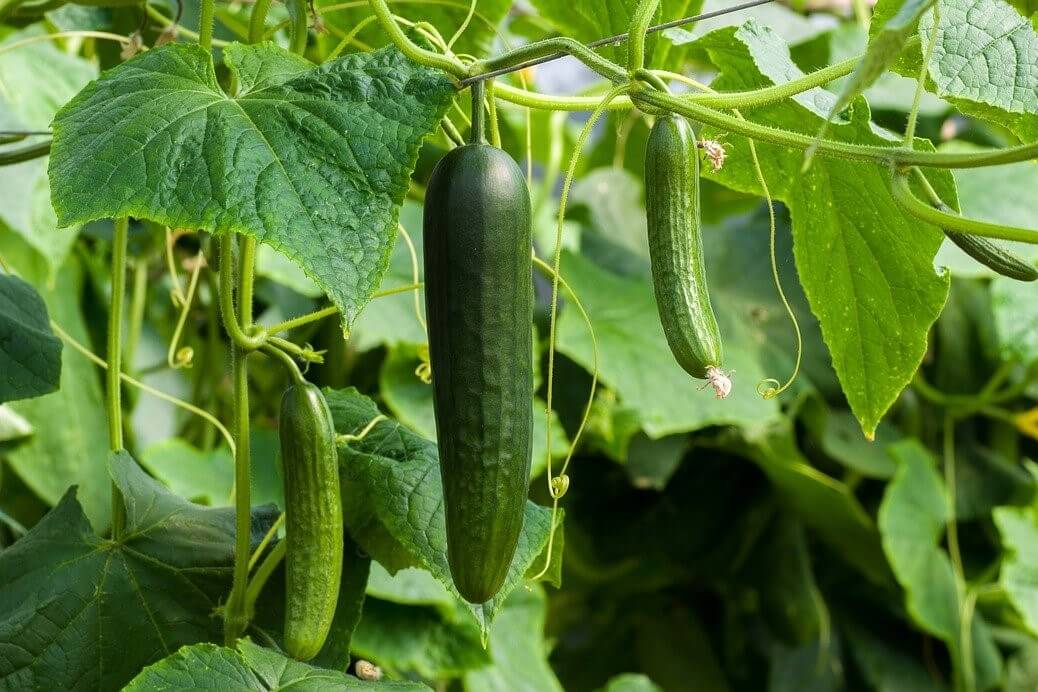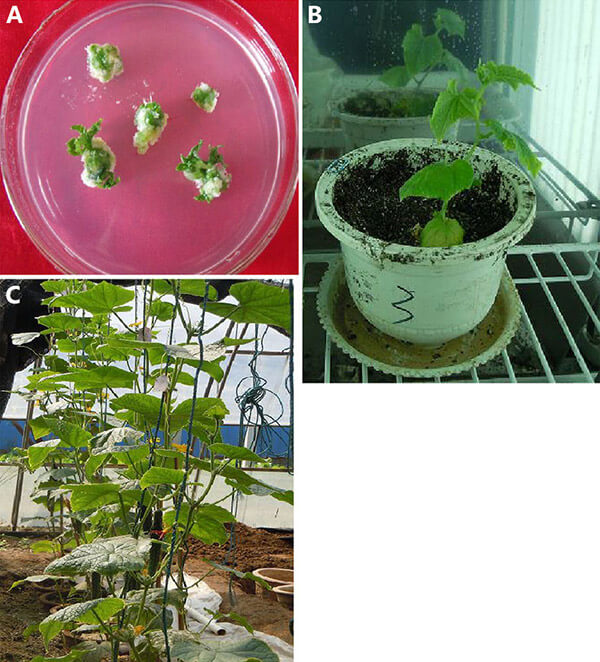Cucumis sativus L., also known as cucumber, is an annual vine or climbing herb of the Cucurbitaceae family. It is widely planted in temperate and tropical regions. It is one of the main summer vegetables. The stems and vines can be used for medicinal purposes and can reduce inflammation and expectorant. Cucumber skin and pulp are rich in nutrients, containing protein, carbohydrates, vitamin C, vitamin E, carotene, niacin, calcium, phosphorus, iron, and other nutrients. Cucumber is also the lowest calorie vegetable in the world, which is very suitable for dieters. In recent years, in order to further improve the characteristics of cucumbers, reduce their cultivation costs, and shorten the cultivation cycle, many genetic modifications have been applied on cucumbers. Through these genetic modifications, we can improve cucumber's disease resistance, insect resistance, salt tolerance, cold tolerance, storage tolerance, fruit flavor, etc.

Lifeasible provides one-stop services, covering all steps including experimental design, vector construction, plasmid transformation, positive transplant screening and characterization of transgenic Cucumis sativus L., our various genetic modification services are as follows:
Gene overexpression plays a key role in gene function research. The development of gene overexpression technology helped us to study gene function and improving the yield of valuable products. Through the quantitative overexpression of genes related to vitamin b2, carotene, niacin, and other chemical components in Cucumis sativus L., the production of specific compounds can be increased. We could help our customer overexpress many genes including manganese stress regulatory gene CsMTP6, salt stress response gene CmoNAC1, gene TFL1 that regulates cucumber growth, autophagy gene CsATG8C that affects cucumber growth and resistance to stress, branching gene CsDAD2, and many other genes related to important traits of Cucumis sativus L.
RNAi technology is widely used in the field of gene editing, it is a phenomenon of specific gene silencing mediated by double-stranded RNA (dsRNA) and involved in specific enzymes. It blocks gene expression at the transcription level and post-transcriptional level. Through RNAi technology, we can achieve silencing of multiple genes in Cucumis sativus L.
Virus induced gene silencing (VIGS) is a genetic technology that inhibits the expression of endogenous genes in plants by inserting recombinant viruses into target gene segments, they can induce plant endogenous gene silencing and cause phenotypic changes, and then study the function of target genes based on phenotypic changes. The VIGS technology is a method of transient transformation and underlying molecular basis may be post-transcriptional gene silencing. Silencing and functional analysis of target genes in Cucumis sativus L. through VIGS can help our customers save time and obtain valuable information for gene functional analysis. With wealth of experience in VIGS, our scientists can provide you with customized protocol for VIGS in Cucumis sativus L.
CRISPR gene knockout technology is currently the most widely used gene knockout technology, it provides us with a very powerful and convenient gene editing tool. As a leading company that has been deeply involved in the field of gene editing for many years, with CRISPR technology, we can knockout Cucumis sativus L. genes in different ways, including frameshift mutations, multiple deletion of fragments, knockout of non-coding genes, knockout of multiple copies of genes, etc.
CRISPR system has strong scalability, and this scalability can be used to develop more useful gene editing tools. we have developed many methods that can improve gene knock-in efficiency and achieve precise editing of the Cucumis sativus L. genome. For the gene knock-in process, most of them is done through HDR. However, NHEJ and HDR will occur at the same time due to DNA breaks. Therefore, we have developed different methods to increase the probability of HDR, thereby improving the efficiency of gene knock-in process.
CRISPR Single base editing technology is a hot area of life science research today. As a company that has been cultivating gene editing technology for decades, Lifeasible could help you achieve the conversion from C to T or A to G in Cucumis sativus L. using CBE and ABE, both of which rely on the DNA positioning capabilities of the CRISPR/Cas9 system. During single base editing, the C base deaminase or A base deaminase is located at a specific position in the genome, and it catalyzes the deamination reaction of C or A at a specific position and turns it into U or I. Then it is treated as T or G in the process of DNA replication, realizing the conversion from C to T or A to G.
Sequence-specific control of gene expression on a genome-wide scale is an important approach for understanding gene functions and for engineering genetic regulatory systems, one of them is CRISPR Interference (CRISPRi). There are many ways to participate in the inhibition of gene expression. For the inhibition of Cucumis sativus L. genes, we can provide a variety of solutions, including dCas9 binding to targeted DNA and realizing Inhibition of gene transcription through steric hindrance. In addition, gene knockdown can also be achieved by recruiting a fusion protein to the start site of gene transcription.
CRISPRa technology uses the powerful capabilities of Cas9 and sgRNA to fuse or recruit multiple proteins to enhance gene transcription. For Cucumis sativus L. genes, we provide VPR technology, SAM technology and Suntag technology to allow the CRISPR system to carry more activation element and achieve a stronger activation effect after synergistic amplification.
The study of gene function has always been the core subject of biological research. The earliest genetic screening system established through forward genetics is very inefficient and has a huge workload. However, the reverse genetic screening system based on CRISPR technology can complete very low-cost mutation library construction work. The gene mutation library construction technology we provide for Cucumis sativus L. including gene knockout library construction, gene knockdown library construction, and gene activation library construction. Moreover, single-cell sequencing is available for mutation screening.
DNA-free gene editing technology has received extensive attention from the industry in recent years. We provide DNA free Cucumis sativus L. genome editing services, including transient expression of CRISPR/Cas9 plasmid DNA, in vitro transcription of CRISPR/Cas9, and pre-assembled ribonucleic acid composed of purified Cas9 protein and sgRNAs complex. These technologies can avoid the integration of foreign DNA and genome, and reduce off-target effects. In addition, compared with traditional techniques, these techniques can avoid the use of hybridization or backcrossing to isolate CRISPR/Cas9 chimeras, so they are cheaper and have shorter experimental cycles.
Genetic Transformation Process for Cucumis sativus L.
The most advanced and widely used method for the development of genetically modified Cucumis sativus L. is Agrobacterium-mediated transformation of cotyledonary nodes (Figure 1).
 Figure 1. Agrobacterium mediated Cucumis sativus L. transformation by infecting cotyledonary nodes explants of cucumber. (A) in vitro prolific shoot induction on cotyledonary node, (B) regenerated plant established using the regeneration media, growing in an illuminated incubator, (C) mature regenerated plant in the greenhouse. (Wang J, et al. 2013)
Figure 1. Agrobacterium mediated Cucumis sativus L. transformation by infecting cotyledonary nodes explants of cucumber. (A) in vitro prolific shoot induction on cotyledonary node, (B) regenerated plant established using the regeneration media, growing in an illuminated incubator, (C) mature regenerated plant in the greenhouse. (Wang J, et al. 2013)
Experts at Lifeasible obtain comprehensive knowledge and years of experience to solve technical problems and challenges in Cucumis sativus L. transformation. We can draw customized solution to help you research on a variety of Cucumis sativus L. varieties. Our services guarantee the success of your project. For more information or any inquiry requirements, please contact Lifeasible.
Reference